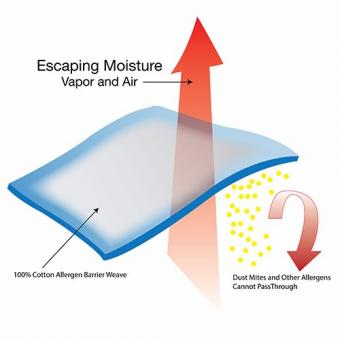
Controlling dust mites in bedding can go a long way to reducing allergic reactions, especially asthma attacks. It only takes a little planning and establishing a routine to learn how to control these pests.
Vacuum Mattresses
The first place you want to start is with the mattresses. European Bedding suggests if you have a fabric-covered mattress, use a combination of baking soda, essential oil, and a HEPA vacuum cleaner. Mix a cup of baking soda with a few drops of your favorite essential oil and sprinkle it on the mattress. Allow it to sit for 15 minutes before vacuuming. Don't do this directly on memory foam; use only on fabric mattress covers.
Use Allergen-Proof Bed Covers
According to Mayo Clinic, the first step toward controlling dust mites is to purchase allergen-proof bed and pillow covers. Select good quality covers made from tightly woven fabrics. This type of fabric prevents dust mites from burrowing from the mattress and keeps them contained.
Covers for Box Springs and Top Mattress
Purchase allergen-proof covers for both the box springs and top mattress. Choose zipper styled covers to ensure both the foundation (box springs) and the top mattress are encased. This type of cover will stop the dust mites, preventing them from passing through the fabric.

Pillow Covers
You'll also want to purchase allergen-proof pillow covers.
- Feather pillows are prone to dust mites more than synthetic types of pillows. Be sure you use pillow covers for this type of pillow.
- Select zipper covers so you can be certain of protection against dust mites.
Once you're sure the mattresses and pillows are completely encased, you can make the bed.

Wash Bed Linens Weekly
The next preventative step you want to take in your quest to control dust mites is to wash the bedding every week.
- Wash the sheets, pillowcases, and any blankets or throws you use as well as bedspreads and comforters.
- Don't forget to add the bed pillows to the wash load.
- The temperature required to kill dust mites is 130°F (54.4°C). Most washing machines' hot water settings reach this temperature. You can always check with the owner's manual or the manufacturer.

Non-Washable Bedding
Many comforters, duvets, bedspreads, and quilts aren't washable. If your bedding has to be dry cleaned, you can still kill dust mites by placing it in the dryer weekly. Set the dryer for 15 to 20 minutes at a minimal temperature setting of 130°F (54.4°C). Another way to kill dust mites for non-washable bedding, such as silk, is to place it in the freezer for a minimum of 24 hours.
Use Hypo-Allergenic Bedding
You can certainly up your game by purchasing special allergy free bedding, such as sheets, pillowcases, comforters, and duvet covers. This type of bedding choice can help alleviate any allergic reactions to dust mites and other allergens.
Use Essential Oils to Fight Dust Mites
According to the National Institutes of Health, a study conducted on how essential oils may control dust mites gave successful results. The test results concluded using essential oils against dust mites had a time limit on its effectiveness, but it was effective. The essential oils that showed promise in fighting dust mites included, clove, matrecary, chenopodium, rosemary, eucalyptus, and caraway. The research team concluded, "This study suggests the use of the essential oils and their major constituents as ecofriendly biodegradable agents for the control of house dust mite."
Eucalyptus Essential Oil Pre-soak
Another study published in The Journal of Allergy and Clinical Immunology concluded you can pre-soak bedding for 30 minutes and kill dust mites. Using a low concentration of 0.2% eucalyptus essential oil without the use of hot water, 97 percent of the dust mites were killed.
How You Can Use Essential Oils
There are a few ways you can use essential oils in your fight against dust mites.
- Add a few of drops of essential oil into a 30-minute pre-soak cycle.
- Add a couple of drops to a plain cloth and toss it into the dryer with the bedding.
- Spray diluted essential oil onto mattresses and pillows, then encase them with a zipper cover.
Other Tips for Fighting Dust Mites
One of the important tools you can use to fight dust mites is to control the humidity in the bedrooms. The American Academy of Allergy Asthma and Immunology advises you keep the humidity below 50 percent. This will slow the dust mite population growth. In addition to all tactics to control dust mites, you may want to try one of the numerous laundering products that claim to control/kill dust mites. Try a few to see what type of results you get.
Controlling Dust Mites in Your Bedding
There are several housekeeping tactics to controlling dust mites in bedding. You can also try using the essential oils or some of the laundry products available. If you're diligent in these practices, you can eliminate much of the problem of bedding dust mites.







